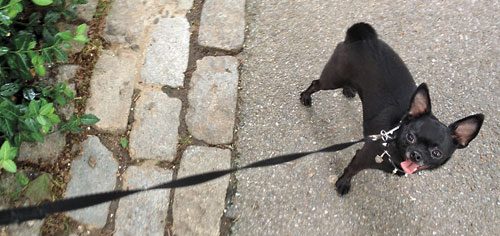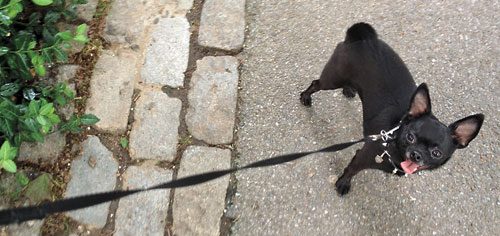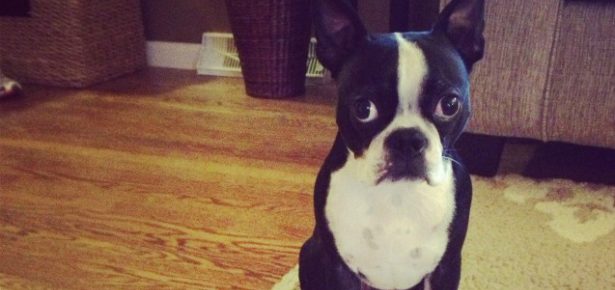

In Defense of the City Dog
An urban dog lover writes an open letter to the people who told her they would never keep a dog in New York City
People often say to me, "I could never have a dog in the city." And I just shake my head in a sort of circular, nonresponsive, thanks-for-your-comment kind of way. See, I live in New York City, and I’ve had anywhere from one to five dogs at a time during the past 16 years. I can’t say it’s always been easy, but I can say the dogs have always been happy.
Growing up, I lived in Westchester County, in New York, with three 150-pound English mastiffs, so I’m familiar with the lives of suburban dogs. A few times a day our dogs would push open the screen door in the kitchen to prance across the yard. Minutes later, they’d scurry inside to sleep, which was more compelling than any amount of exercise or human interaction. In the city, I walk my three dogs — one Boston terrier and two Boston terrier-chihuahua mixes — four times a day. In Central Park, my little pack wreaks havoc on unsuspecting squirrels and then comes home to have a treat and look for a nice place to take a four-hour nap. If you ask me, my dogs’ daily routine is just like a country dog’s, only better.
"Cozy" is the real-estate euphemism for my smallish Manhattan apartment. There’s ample space for my family (human and canine), but my pets are always in the room with me — even if that room is the bathroom. As a writer, I work at home, with the dogs perched at my feet, on my lap, or, sometimes, on my keyboard. Living in such close quarters, I have a greater intimacy with these dogs than I did with my dogs growing up.
I always wondered what the mastiffs were doing when they would disappear into the woods. They would return as mysteriously as they had left, pierced by porcupine quills, stinking of skunk, or just smelling faintly of something odd and unpleasant. That’s not the case with my city dogs. I am complicit as I watch them roll in pigeon poop or try to eat a candy wrapper. We’re tight like that.
Plus, my dogs are used to fire-truck sirens, crowded sidewalks, and popping balloons. For the most part, they just roll with it — or in it. Their changeable environment has forced them to be adaptable. I’ve had dogs that would sit at an outdoor table with me at a bistro or wait on my lap while I got my hair cut. They are far more integrated into my life than they would be if we lived in the country.
When we’re at my parents’ house in the suburbs and the dogs notice me packing to leave, they jump into the open car and wait — even if it’s hours. Because to them the city is ours. They don’t know that the park isn’t our backyard. And I, for one, am not about to tell them.
Still, there are people who are uncomfortable with this. (There are also people who don’t understand how I can raise a child in the city.) But we are happy here. And I am fairly certain we would not be happy in another place. At the end of a weekend in the country, the lot of us– dogs and kid–are ready to go back to the noise and the lights and the action. It’s the place we call home.
Julie Klam is the author of Love at First Bark and You Had Me at Woof. Her latest book is Friendkeeping: A Field Guide to the People You Love, Hate, and Can’t Live Without (Riverhead, October 2012).
Muttropolis
Marc Morrone, host of "Ask Marc, the Petkeeper" on Martha Stewart Living Radio, and Arthur Hazlewood, senior director of the ASPCA Adoption Center, tell us what helps dogs thrive in an urban environment.
1. New Experiences
"City dogs kept by responsible petkeepers are walked about in the city and are able to see a lot more of the world than country dogs," says Morrone. "There are so many dog-friendly stores in cities. A shopping trip is a lesson in socialization for your dog," adds Hazlewood.
2. Exercise
"A dog’s happiness depends on physical activity and mental stimulation," says Hazlewood. "Even in an apartment building, you can climb stairs with your dog to expend energy."
3. Adaptability
"Dogs can live almost anywhere," says Morrone. "They’re one of the most adaptable animals on the planet."
4. Indoor Fun
"If pet owners are going out, they can leave a dog with a puzzle toy or put on calming music to provide the right company for dogs when left alone," says Hazlewood.
Copyright © 2012, Martha Stewart Living Omnimedia, Inc. Originally published in the January issue of Martha Stewart Living.
Join the newsletter and never miss out on dog content again!
"*" indicates required fields
By clicking the arrow, you agree to our web Terms of Use and Privacy & Cookie Policy. Easy unsubscribe links are provided in every email.





